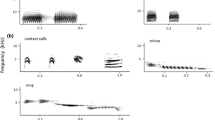Summary
In laboratory studies we analysed the reaction of aMacrotermes subhyalinus (Rambur) colony in contact with a small group of test termites placed at the head of a gallery system. As test termites we usedMacrotermes subhyalinus of the same nest,Macrotermes subhyalinus of a foreign nest and the related sympatric speciesMacrotermes bellicosus (Smeathman).
Contact with an introduced group of foragers evokes a significant recruitment of workers and minor soldiers. The intensity of the response depends on the test groups we introduced. The highest recruitment results withM. bellicosus andM. subhyalinus from a foreign nest. During the recruitment the increase in the number of minor soldiers is greater than the increase in the number of workers, and as a result, the relative proportion of the soldiers in the population leaving the nest is significantly higher than before.
Direct observations at the place of contact show thatM. bellicosus individuals are immediately attacked and killed. In the case ofM. subhyalinus from a foreign nest, not all individuals are killed; some are only intensively examined with the antennae or seized with the mandibles.M. subhyalinus from the same nest are rarely attacked. Mostly they are antennally inspected or enter the gallery system unhindered.
The recruitment of termites from the nest is released by major workers which, after contact with the test termites, run back into the nest and provoke an alarm by tactile stimuli. On their way back into the nest the major workers, in all probability, lay a pheromone trail which leads the outgoing alarmed termites towards the place of contact.
Similar content being viewed by others
References
Adams, E. S., 1991. Nestmate recognition based on heritable odors in the termiteMicrocerotermes arboreus.Proc. Natl. Acad. Sci. USA. 88:2031 -2034.
Adams, E. S. and S. C. Levings, 1987. Territory size and population limits in mangrove termites.J. Anim. Ecol. 56:1069–1081.
Bagnères, A. G., A. Killian, J. L. Clément and C. Lange, 1991. Interspecific recognition among termites of the genusReticulitermes: Evidence for a role for the cuticular hydrocarbons.J. Chem. Ecol. 17:2397–2420.
Bagnères, A. G. and J. L. Clément, 1992. Chemical polymorphism in termites of the genusReticulitermes. Proc. 19th Int. Congr. Entomol.:245.
Binder, B. F., 1988. Intercolonial aggression in the subterranean termiteHeterotermes aureus (Isoptera: Rhinotermitidae).Psyche. 95:123–137.
Clément, J. L., 1986. Open and closed societies inReticulitermes termites (Isoptera, Rhinotermitidae): Geographic and seasonal variations.Sociobiol. 11:311–323.
Darlington, J. P. E. C., 1982. The underground passages and storage pits used in foraging by a nest of the termiteMacrotermes michaelseni in Kajiado, Kenya.J. Zool. London 198:237–247.
Grasse, P. P., 1984. La fondation des nouvelles sociétés. In:Termitologia Vol. II Masson, Paris. 65–145.
Haverty, M. I. and B. L. Thorne, 1989. Agonistic behaviour correlated with hydrocarbon phenotypes in dampwood termitesZootermopsis (Isoptera: Termopsidae).J. Insect. Behav. 2:523–543.
Howard, R. W., C. A. McDaniel, D. R. Nelson, G. J. Blomquist, L. T. Gelbaum and L. H. Zalkow, 1982. Cuticular hydrocarbons ofReticulitermes virginicus (Banks) and their role as potential species- and caste-recognition cues.J. Chem. Ecol. 8:1227–1239.
Howard, R. W., B. L. Thorne, S. C. Levings and C. A. McDaniel, 1988. Cuticular hydrocarbons as chemotaxonomic characters forNasutitermes corniger (Motschulsky) andN. ephratae (Holmgren) (Isoptera: Termitidae).Ann. Entomol. Soc. Am. 81:395–399.
Howick, C. D. and J. W. Creffield, 1980. Intraspecific antagonism inCoptotermes aciniformis (Frogatt) (Isoptera: Rhinotermitidae).Bull. Entomol. Res. 70:17–23.
Lepage, M. G., 1981. L'impact des populations récoltanes deMacrotermes michaelseni dans un écosystème semi-aride (Kadjiado, Kenya). 1. L'activité de récolte et son déterminisme.Ins. Soc. 28:297–308.
Levings, S. C. and E. S. Adams, 1984. Intra- and interspecific territoriality inNasutitermes (Isoptera: Termitidae) in a Panamavian mangrove forest.J. Anim. Ecol. 53:705–714.
Lys, J. A. and R. H. Leuthold, 1991. Morphology of the gallery system around the nest and gallery development under experimental conditions in the termiteMacrotermes bellicosus (Smeathman).Ins. Soc. 38:63–76.
Nel, J. C. C., 1968. Aggressive behaviour of the harvester termitesHodotermes mossambicus (Hagen) andTrinervitermes trinervoides (Sjöstedt).Ins. Soc. 15:145–156.
Pearce, M. J., R. H. Cowie, A. S. Pack and D. Reavey, 1990. Intraspecific aggression, colony identity and foraging distances in SudaneseMicrotermes ssp. (Isoptera: Termitidae: Macrotermitinae).Ecol. Entomol. 15:71–77.
Stuart, A. M., 1976. Some aspects of communication in termites.Proc. 15th Int. Congr. Entomol. 400–405.
Su, N. Y. and R. H. Scheffrahn, 1988. Intra- and interspecific competition of the Formosan and the eastern subterranean termite: evidence from field observations (Isoptera: Rhinotermitidae).Sociobiol. 14:157–164.
Su, N. Y. and M. I. Haverty, 1991. Agonistic behavior among colonies of the Formosan subterranean termite,Coptotermes formosanus Shiraki (Isoptera: Rhinotermitidae), from Florida and Hawaii: Lack of correlation with cuticular hydrocarbon composition.J. Insect Behav. 4:115–128.
Thorne, B. L., 1982. Termite-Termite interactions: workers as an agonistic caste.Psyche 58, 1–2:133–150.
Thorne, B. L. and M. I. Haverty, 1991. A review of intracolony, intraspecific and interspecific agonism in termites.Sociobiol. 19:115–145.
Traniello, J. F. A. and S. N. Beshers, 1985. Species-specific alarm/recruitment responses in a neotropical termite.Naturwiss. 72:491–492.
Watson, J. A. L., E. C. Metcalf and J. J. Sewell, 1975. Preliminary studies on the control of neotenic formation inMastotermes darwiniensis Frogatt (Isoptera).Ins. Soc. 22:415–426.
Author information
Authors and Affiliations
Rights and permissions
About this article
Cite this article
Kettler, R., Leuthold, R.H. Inter- and intraspecific alarm response in the termiteMacrotermes subhyalinus (Rambur). Ins. Soc 42, 145–156 (1995). https://doi.org/10.1007/BF01242451
Received:
Revised:
Accepted:
Issue Date:
DOI: https://doi.org/10.1007/BF01242451




